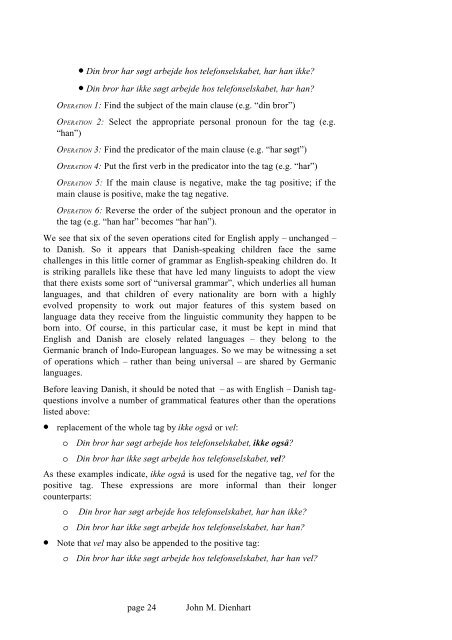Download - VISL
Download - VISL
Download - VISL
You also want an ePaper? Increase the reach of your titles
YUMPU automatically turns print PDFs into web optimized ePapers that Google loves.
• Din bror har søgt arbejde hos telefonselskabet, har han ikke?<br />
• Din bror har ikke søgt arbejde hos telefonselskabet, har han?<br />
OPERATION 1: Find the subject of the main clause (e.g. “din bror”)<br />
OPERATION 2: Select the appropriate personal pronoun for the tag (e.g.<br />
“han”)<br />
OPERATION 3: Find the predicator of the main clause (e.g. “har søgt”)<br />
OPERATION 4: Put the first verb in the predicator into the tag (e.g. “har”)<br />
OPERATION 5: If the main clause is negative, make the tag positive; if the<br />
main clause is positive, make the tag negative.<br />
OPERATION 6: Reverse the order of the subject pronoun and the operator in<br />
the tag (e.g. “han har” becomes “har han”).<br />
We see that six of the seven operations cited for English apply – unchanged –<br />
to Danish. So it appears that Danish-speaking children face the same<br />
challenges in this little corner of grammar as English-speaking children do. It<br />
is striking parallels like these that have led many linguists to adopt the view<br />
that there exists some sort of “universal grammar”, which underlies all human<br />
languages, and that children of every nationality are born with a highly<br />
evolved propensity to work out major features of this system based on<br />
language data they receive from the linguistic community they happen to be<br />
born into. Of course, in this particular case, it must be kept in mind that<br />
English and Danish are closely related languages – they belong to the<br />
Germanic branch of Indo-European languages. So we may be witnessing a set<br />
of operations which – rather than being universal – are shared by Germanic<br />
languages.<br />
Before leaving Danish, it should be noted that – as with English – Danish tagquestions<br />
involve a number of grammatical features other than the operations<br />
listed above:<br />
• replacement of the whole tag by ikke også or vel:<br />
o<br />
o<br />
Din bror har søgt arbejde hos telefonselskabet, ikke også?<br />
Din bror har ikke søgt arbejde hos telefonselskabet, vel?<br />
As these examples indicate, ikke også is used for the negative tag, vel for the<br />
positive tag. These expressions are more informal than their longer<br />
counterparts:<br />
o Din bror har søgt arbejde hos telefonselskabet, har han ikke?<br />
o Din bror har ikke søgt arbejde hos telefonselskabet, har han?<br />
• Note that vel may also be appended to the positive tag:<br />
o<br />
Din bror har ikke søgt arbejde hos telefonselskabet, har han vel?<br />
page 24<br />
John M. Dienhart
















